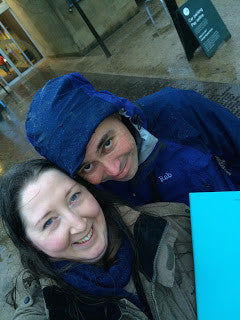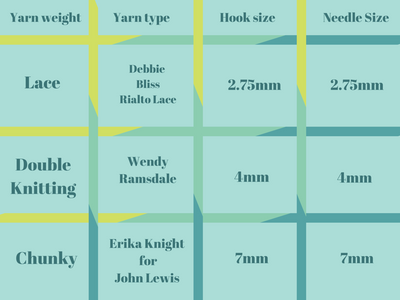
Before you go any further, this review is going to read like a love letter to Yarnadelic and that's because it is.
I first encountered this yarn back in June of 2019 when the initial fibre top of the 'Black Gold of the Sun' colourway was being shown at the John Arbon Open Weekend. During the open weekends, a couple of Weavers, Spinners and Dyers Guilds come and show people how to spin on different wheels. One of the spinners was using the new top and when finished, a member of the John Arbon Team was walking around with it playfully. My reaction to the yarn was visceral - I had to have it.
The thing with bringing out a new yarn range is that it takes a while to develop. I did manage to get my grubby little mitts on a mini skein (yes they are selling those as well as 100g skeins - huzzah!) so that I could pull this review together.
So, we are now at the end of January 2020, a mere seven months on from my love at first sight moment and I have a jumper's quantity of Yarnadelic in the colourway 'Badi Da'.
The package arrived, I squished it and went straight to my Stash Palace to cake up the first skein. By the end of the evening, a pattern had been chosen and my gauge swatch was drying. This has never happened before. So what follows next is just why Yarnadelic has gone straight to the top of my yarn chart. Standard details on the yarn are given at the bottom.
Weight
Yarnadelic is a sportweight yarn. This isn't a standard UK (it is in the US and elsewhere) weight but is definitely a weight of yarn I predict you will see more of. It sits slightly more towards the 4ply than the DK end of the yarn spectrum,
I love working with a sportweight yarn for both crochet and knitting because it's quicked to work up than a 4 ply yarn and gives an extra bit of thickness and squish to whatever it is you are making.
Because the sportweight is closer to 4ply in yarn weight, you can usually do some simple swatching and maths to use this weight for your earmarked 4ply patterns. I dare say you cant. do the same for DK patterns too, I just haven't attempted that yet.
Feel
It is snuggly soft! I am also a fan of their Knit by Numbers range which is 100% Organic Falklands Merino. Yarnadelic is almost as soft ay Knit by Numbers but in my opinion, the cross-breeding of Merino with Lincoln Longwool to get Corriedale gives it just a little more bite, opening up more options for how you might want to use this yarn.

Image text: soft terracotta background with a cake of squishy Yarnadelic wool in the foreground. It has a base of blue with dark fawn brown heathered throughout the yarn. It shows quite a high twist on the strand.
Yarnadelic also seems to have a higher twist to it than much of the rest of the John Arbon Textiles range.
Crochet
To test out this yarn with crochet, I used a 3mm (C2/D3) hook for the ribbing and a 3.5mm hook (E/4) for the bottom of the mitten. I found that the larger hook was easier to use and created a lovely fabric.
The mitten shown is just something I quickly designed to make my Yarnadelic yarn go as far as possible. I paired Yarnadelic with their Harvest Hues 4ply yarn in colour 'Bracken' and although Harvest Hues is a true 4ply (400m/100g), it works really nicely with the sportweight Yarnadelic.

Image text: segmented photo of terracotta background showing a full mitten with rib and starting rows in Yarnadelic colourway 'Black Gold of the Sun' transitioning through some simple colourwork into the rusty orange colour that is Bracken from the Harvest Hues range. The segment to the right shows a close up of the rib and Yarnadelic in htr and dc crochet (hdc and sc in US). The bottom segment shows a grey background with a mini skein of Black Gold of the Sun - the main colour is very dark green, nearing charcoal with the obvious blending of yellow and blue.
If you are going to crochet with this yarn, I suggest starting a hook size up from your normal 4ply choice.
It's also worth noting that the higher twist in the ply of Yarnadelic means that it isn't prone to splitting and is an absolute delight to crochet with.
Knitting
Again, I paired the yarn with the same Harvest Hues 4ply so that I could get the most from my 25g and offer a crochet and knitted sample.This time I went for a hat (Tiny Boats by Elizabeth Doherty) so that I could test how it reacted on my forehead (this and my wrists are the two main areas on my body that will react to wool fibres).
The hat makes use of slip and dipped stitches and the yarn reacted well to the extra strain that these can create.
The yarn was a delight to work with across the three needle sizes that the pattern requires (3.5, 4 and 4.5mm).

Image text: segmented photo of terracotta background showing the rim of a hat in Yarnadelic colourway 'Black Gold of the Sun' transitioning through some simple slip and dipped stitches into the rusty orange colour that is Bracken from the Harvest Hues range. The segment to the right shows a close up of the whole hat. The top segment shows a grey background with a mini skein of Black Gold of the Sun - the main colour is very dark green, nearing charcoal with obvious blending of yellow and blue.
As soon as I had finished knitting that hat I knew that I wanted to knit a garment with this yarn and ordered it as soon as it became available to Mill Members (check it out if you haven't already signed up - it's how I got my hands on six skeins of Yarnadelic before it officially launched)
I have worn the hat a few times and it's soft on my forehead, lightweight and warm - basically everything you need from a hat yarn.

Image text: terracotta background showing the rib of a jumper in Yarnadelic colourway 'Badi Da'. To the left are two skeins of Badi Da with their black and dark terracotta skein bands. A cake of yarn sits to the top right. Badi Da is a soft bluey grey with strands of dark fawn blended throughout.
Needless to say, I have already cast on my jumper. I'm making Hay by Clare Mountain-Manapon, which was from Issue Three of Laine Magazine and is available to buy on Ravelry. I think that the simplicity of the design with the small lace panels will really show the melange shading of Badi Da off to best effect.
Spit Splicing
I hate weaving in ends, so like to test spit splicing as part of my yarn reviews. Yarnadelic spit-spliced (using spit and your hands to create friction and heat to merge two yarn ends together) in a matter of seconds. I didn't even cut away some of the ply from both ends, I just spit spliced 3cm of each end together and it was one piece of yarn on no time at all.
Stitch definition
I think that there is good stitch definition for both crochet (I used dcs (scs in US)) and knitting. It's that natural kind of good and slightly fuzzy definition you get with non-superwash yarn as opposed to the overly rigid, and uniform stitches that superwash yarns can create.
Blocking
I can't really comment of the hat or mittens yet because I haven't blocked the mittens and the hat has slip and dipped stitches so wouldn't give me a true reading for how Yarnadelic blocks.
I did, however, wash my gauge swatch for Hay. There was very little movement of stitch count or row count, just a slight increase in both directions.
I will add to this part of the review when I can add unblocked and blocked gauge from my Hay jumper.
Uses
For crochet and knitting, I would happily use this for blankets, garments, accessories. I think it particularly lends itself to crochet colourwork because of the melange effect in the yarn. Also, it's sold in 25g skeins as well, so you could really build up some beautiful items from the 18 colourways available.
I suspect that the cross-breeding of the Merino and Lincoln Longwool makes this a good option for knitted colourwork. For those that are unable to deal with more 'characterful' yarns and prize softness above all else, this gives you a good option for stranded colourwork because there is a bit of toothyness about it.
My other hunch is that it will pill less, making it a good, soft option for garments. Again, I will feedback when I have knitted and worn my Hay jumper.
Colours
There are 18 colours in the Yarnadlic range. In some, the melange effect is very obvious (Nobody knows, Black Gold of the Sun, English Sparrows, Waltz, Hey Moon, and Badi Da (my favourite).

Image text: dark grey background with a white sheep of A5 card. The card has 18 punched holes and each of the holes houses strands of the Yarnadelic range.
For the others, the blend is less apparent - they definitely don't look like solid colours but the heathering is less obvious. I think this makes it a perfect palette for using multiple colours of Yarnadelic in the same project.


Image text: Left - dark grey background with close up of 9 shades from mid fawn through to a deep raspberry pink. Right - the next 9 shades range from a mid rose pink to Badi Da - the gorgeous blu/fawn heathered one.
In five
I like to choose five words that sum up how I feel about yarns I review:
Soft
Heathered
Warm
Swoon
Favourite
The Yarn Info
Inspired by John's extensive and eclectic record collection, Yarndalic is a Sportweight/heavy 4ply wool (333m per 100g, 83m per 25g, 3/10nm). It's 100% Falklands Corriedale ( a cross of Merino and Lincoln Longwool) which is grown without mulesing.
The fibre is dyed in the UK and prepared, blended and spun at the John Arbon Textile mill in North Devon.
The 18 colours available, have a melange effect - a beautiful medley of colours that have been brought to the yarn pairing and blending.
100g skein - £17.50
25g skein - £5.75 or 6 for £32
100g fibre tops - £5.50
Patterns that are suitable for this yarn are available from the John Arbon Textiles website.







